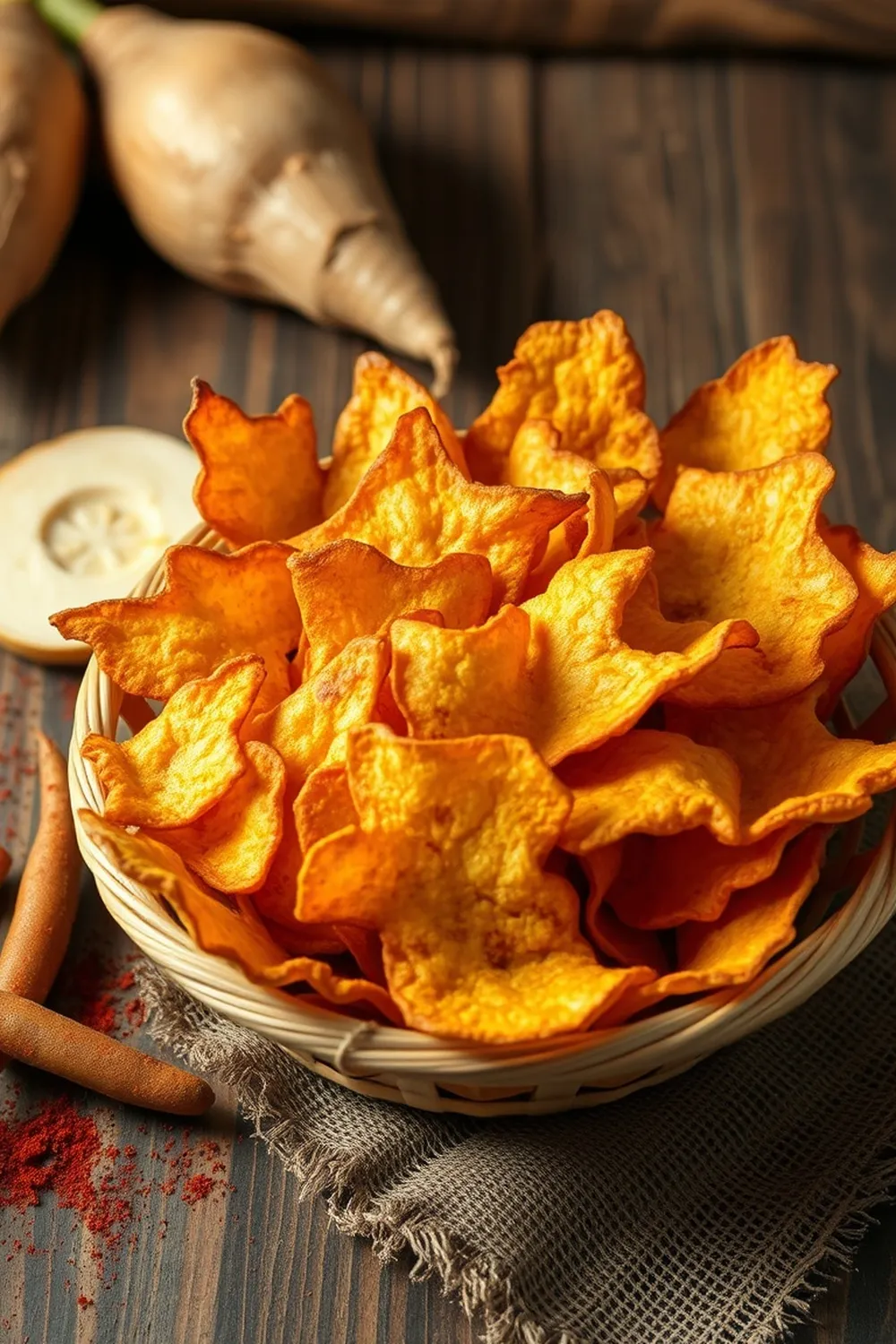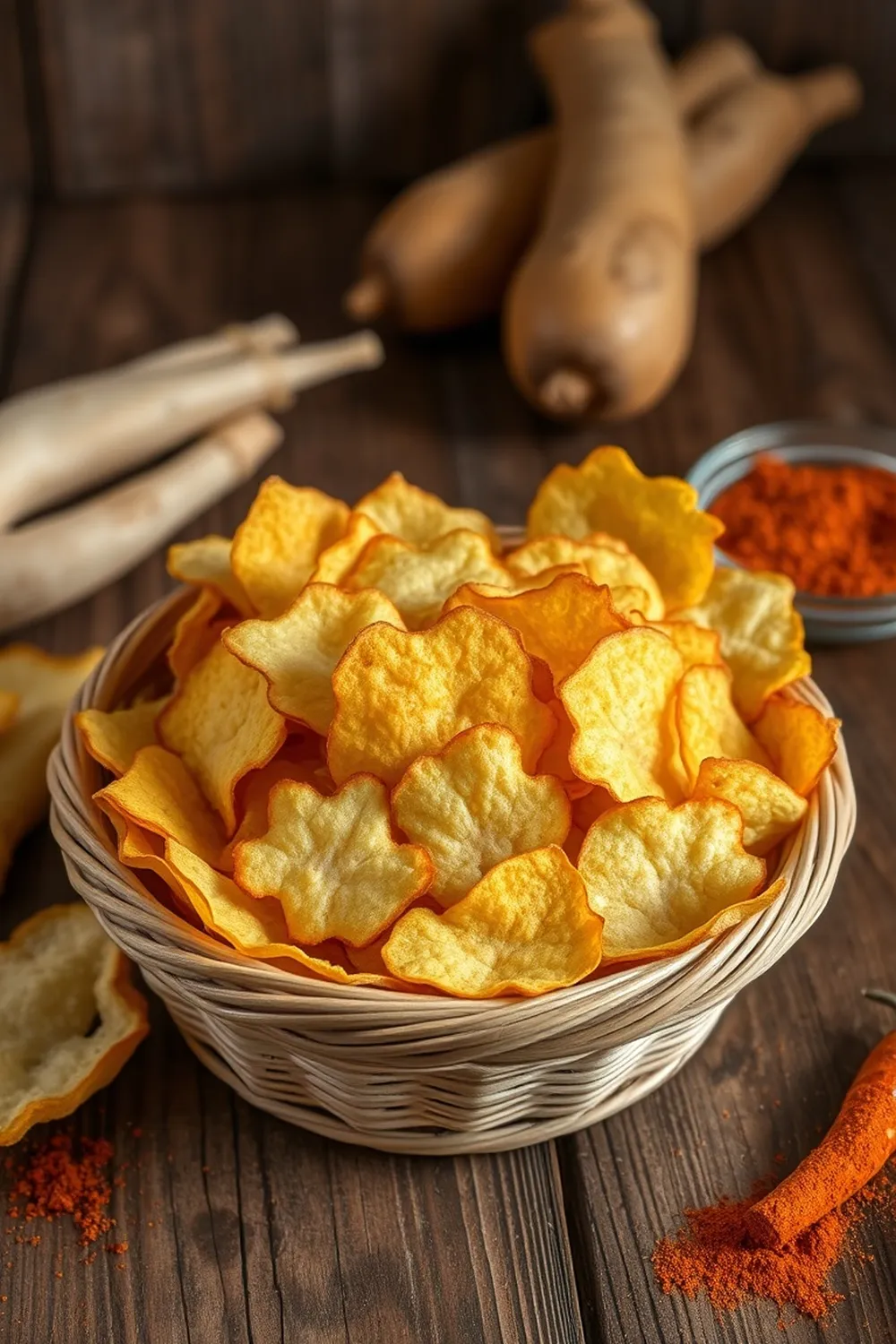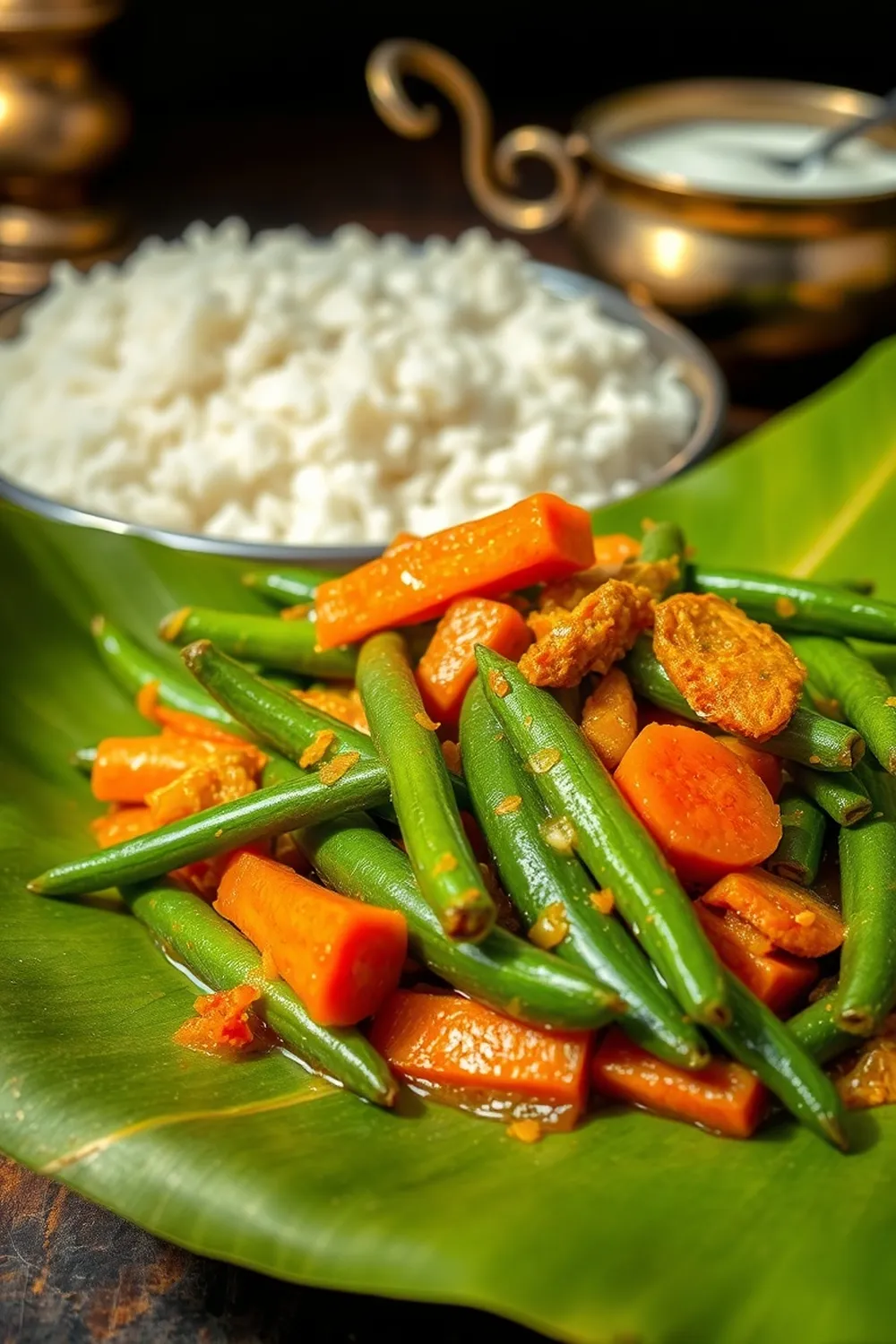- Trim the ends of the cassava roots and remove the thick outer skin using a knife.
- Wash the roots thoroughly and slice into paper-thin rounds (less than 1/8 inch) using a mandolin.
- Pat the slices dry with paper towels to remove moisture.
- Heat peanut oil to 375°F (190°C) in a deep fryer or heavy pot.
- Fry the slices in batches until golden and crisp, avoiding overcrowding.
- Drain the chips on paper towels and sprinkle with salt immediately.
- Cool completely before storing in an airtight container for up to 5 days.
- Calories:745 kcal25%
- Energy:3117 kJ22%
- Protein:1 g28%
- Carbohydrates:26 mg40%
- Sugar:1 mg8%
- Salt:106 g25%
- Fat:72 g20%
Last Updated on 5 months ago by Neha Deshmukh
Crispy Cassava Chips Recipe – Authentic Indian-Style Yuca Fries
Hey everyone! If you’re anything like me, you love a good crunchy snack. And let me tell you, these crispy cassava chips are seriously addictive. I first made these when I was craving something different from the usual potato chips, and honestly, they’ve become a staple in my house ever since. They’re a fantastic alternative to fries, and a little bit different – in the best way possible! Let’s get cooking, shall we?
Why You’ll Love This Recipe
These aren’t just any chips. They’re a delightful blend of textures – perfectly crisp on the outside, soft and slightly chewy on the inside. Plus, they’re naturally gluten-free and can easily be made vegan. They’re a fun way to explore a different root vegetable and impress your friends and family with a unique, flavorful snack. Trust me, once you try these, you’ll be hooked!
Ingredients
Here’s what you’ll need to make a big batch of these delicious chips:
- 2 fresh Yuca/cassava roots
- 4 cups peanut oil (about 950ml)
- ?? teaspoon salt (start with 1 tsp and adjust to taste)
Ingredient Notes
Let’s talk ingredients for a sec. Getting these right makes all the difference!
Cassava/Yuca Root Varieties
You’ll want to look for firm, unblemished cassava roots. There are two main types: sweet and bitter. We’re using the sweet variety here, which is more common in Indian cooking. It’s important to peel and cook cassava properly, as it contains cyanogenic glycosides which are removed during cooking.
Peanut Oil: Choosing the Right Type
Peanut oil is traditional for this recipe because of its high smoke point and neutral flavor. It gives the chips that lovely, authentic taste. If you have a peanut allergy, see the FAQs for alternative oil options.
Salt: Regional Preferences & Flavors
I usually use a fine sea salt, but you can experiment! Kala namak (black salt) adds a really interesting, savory flavor. Or, for a little kick, try a flavored salt.
Step-By-Step Instructions
Alright, let’s get down to business!
- First things first, trim the ends of your cassava roots and remove the thick outer skin using a knife. It’s a little bit of work, but totally worth it.
- Now, give those roots a good wash. Then, the key to perfect chips is slicing them paper-thin – less than 1/8 inch (3mm) thick. A mandoline is your best friend here, but don’t worry if you don’t have one (we’ll talk about that later!).
- Once sliced, pat the cassava rounds really dry with paper towels. This is super important for getting them crispy. Moisture is the enemy!
- Heat your peanut oil in a deep fryer or a heavy-bottomed pot to 370°F (188°C). Use a thermometer to be sure – we want that perfect frying temperature.
- Carefully fry the cassava slices in batches, making sure not to overcrowd the pot. Overcrowding lowers the oil temperature and results in soggy chips.
- Fry until golden and crisp, usually about 3-5 minutes per batch.
- Remove the chips with a slotted spoon and drain them on paper towels. Immediately sprinkle with salt while they’re still hot.
- Let them cool completely before storing. Seriously, don’t skip the cooling part – they crisp up even more as they cool!
Expert Tips
Want to take your cassava chips to the next level? Here are a few of my go-to tricks:
Achieving Maximum Crispness
Drying the cassava slices thoroughly is crucial. Also, don’t be afraid to fry them a little longer if they aren’t quite crisp enough.
Preventing Sticking
Make sure your oil is hot enough and don’t overcrowd the pot. If the chips are sticking together, gently separate them with a fork while frying.
Oil Temperature Control
Maintaining the oil temperature is key. If it drops too low, the chips will be greasy. If it’s too high, they’ll burn. A good thermometer is a lifesaver!
Variations
Let’s get creative!
Vegan Cassava Chips
This recipe is naturally vegan! Just double-check your salt doesn’t contain any hidden animal products.
Gluten-Free Cassava Chips
Yep, these are naturally gluten-free too! A great option for those with dietary restrictions.
Spice Level Adaptations (Chili Powder, Chaat Masala)
My friend Priya loves to add a pinch of chili powder or chaat masala to the salt for a spicy kick. It’s delicious! Feel free to experiment with your favorite spices.
Festival Adaptations (Diwali Snacks, Festive Gatherings)
These are perfect for Diwali or any festive gathering. They’re a unique and flavorful snack that everyone will enjoy.
Serving Suggestions
These chips are amazing on their own, but they’re also fantastic with:
- Your favorite dip (raita, chutney, or even guacamole!)
- As a side dish with Indian curries
- Sprinkled over salads for a crunchy topping
Storage Instructions
Store cooled cassava chips in an airtight container at room temperature for up to 5 days. They might lose a little of their crispness over time, but they’ll still be delicious!
FAQs
Got questions? I’ve got answers!
What is Cassava/Yuca and where does it grow?
Cassava (also known as yuca) is a starchy root vegetable native to South America, but now grown in many tropical regions, including India. It’s a staple food for millions of people around the world.
Can I use another oil besides peanut oil?
Yes, you can! Canola oil, sunflower oil, or vegetable oil are good alternatives, but they may slightly alter the flavor. Just make sure the oil has a high smoke point.
How can I tell if the oil is hot enough?
A thermometer is the most accurate way. If you don’t have one, drop a small piece of cassava into the oil. If it sizzles immediately and starts to bubble, it’s ready.
What if I don’t have a mandoline?
You can use a sharp knife and a steady hand! Just aim for those paper-thin slices. It will take a little longer, but it’s definitely doable.
How do I prevent the cassava chips from becoming soggy?
Dry the cassava slices thoroughly and don’t overcrowd the pot. Also, make sure the oil is hot enough.
Can I make these ahead of time?
You can slice the cassava ahead of time and store the slices in water to prevent browning. But I recommend frying them right before serving for the best crispness.







